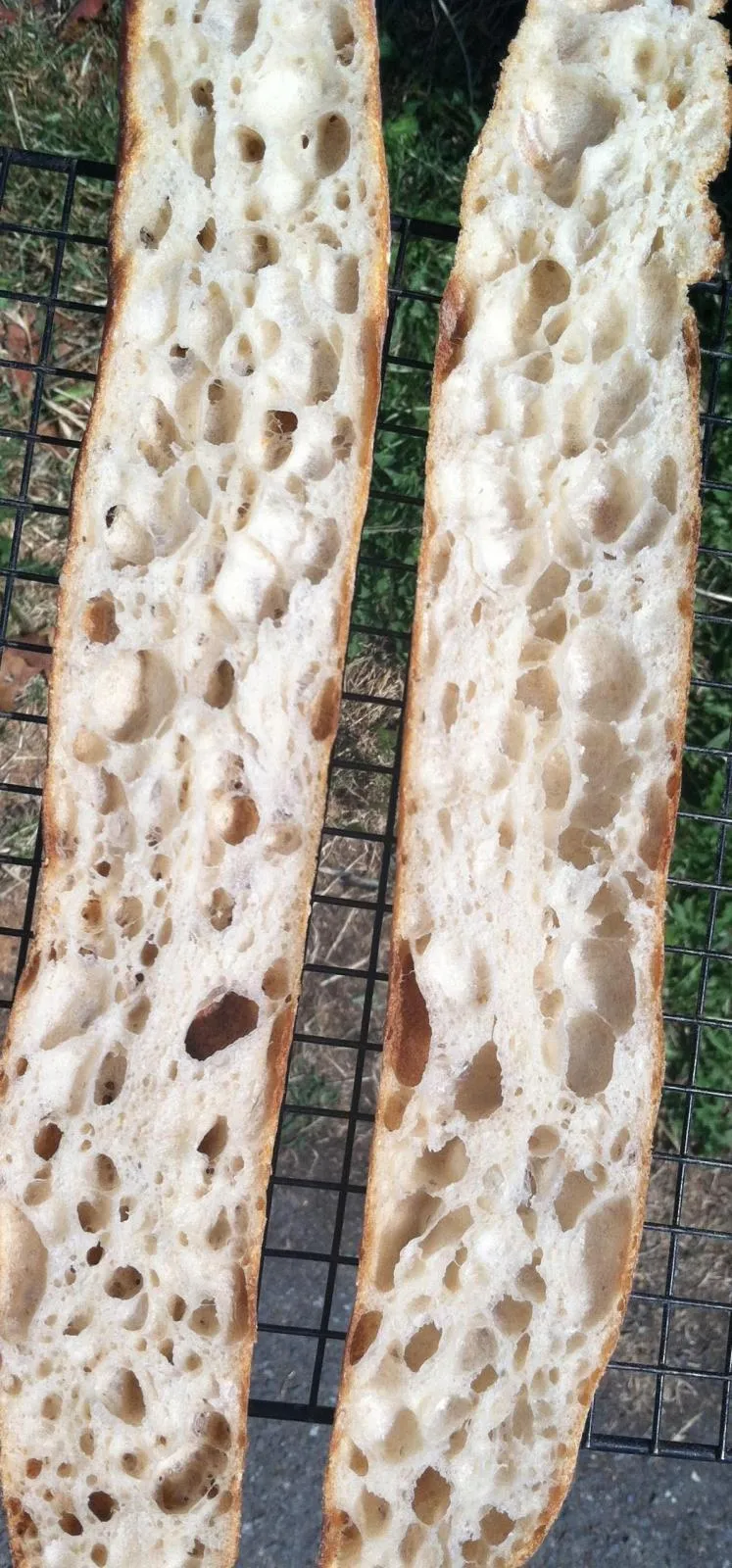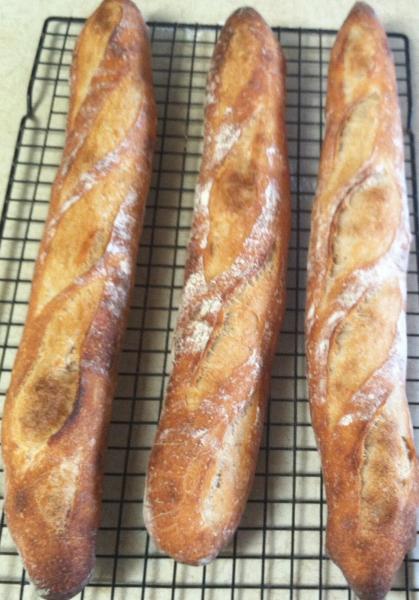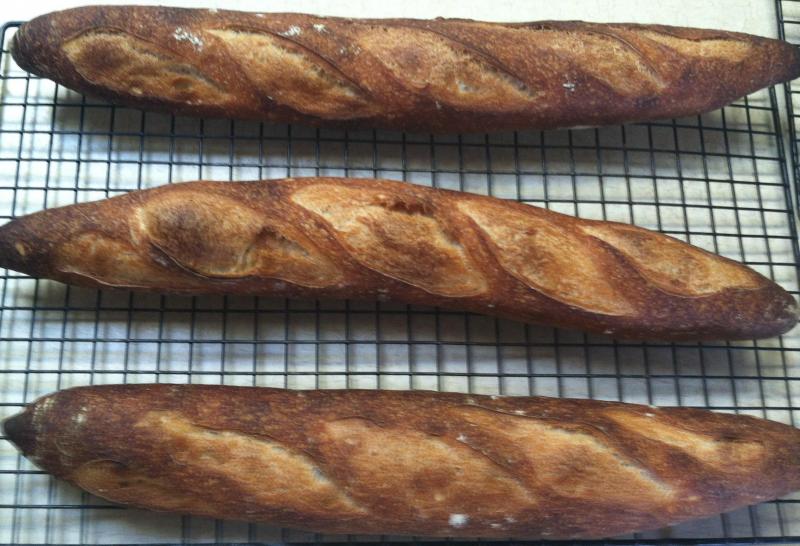
So as all of us who love to make bread, I too, am on the quest to make a perfect baguette. I've made oodles of variations that are quite good and even great but not "the baguette". On the same notion I believe there is more than one "perfect baguette". In fact after working in a few bakeries I've adapted the notion that a well written bread formula can be approached from so many ways. And in many instances they are all good ways of handling the said formula. Its in the eye of the beholder and what they are after. This thought came at a production bread bakery when mixers, bakers, and shapers, although all trained to do things in a relatively specific way, over time adapt "their way". This is a major problem for me as I believe at a single bakery everything should be approached as close to the same in order for consistency. Even if it is true that there are hundreds of different ways to approach the same formula.
This was not my bakery and the changes although drastic at times were mostly unnoticed by the masses. I was able to learn a great deal from this. I saw what the minor/major changes brought to the table. To share some examples: there was the obvious variation of shapes that over time you knew who shaped which loaf. Not too much variation here as this was one of the few things all did very similarly. We all shaped following the same technique. So some of us shaped a bit tighter, some had a specific taper. All in all not much other than minor cosmetics affected here. Next the mixer. This was where things got interesting. Some stuck with the trained plan (as I called par, and i suggested all go par to be most consistent) but 1/2 of the mixers did not. Over time some would adapt. Some would change yeast quantities slightly based on the state of the levain in the recipe, some would adjust hydration at the autolyse, and others would adjust at the finishing mix. This played a huge role in variation. The best results came from those that followed "par". Boring as it may be this business had multiple mixers, and so much overturn, it was best to follow the formula and procedure as trained. Finally there were the bakers. Some liked lots of steam, some less, some like hotter oven, some cooler. This was a huge play in the final loaves and the most notable from the outside. It also played a huge role on finished interior. Since I was trained with all the variation, I too adapted my own style.
So I too will play this game with baguettes at home. Maybe not the prettiest baguettes (that can come later). I'm not used to scoring such little loaves (these are only 250 g each) In fact next test will just increase the size to 300 and follow same formula and see results. I wanted an open crumb but not a very high hydration. Once you get the dough up to 80% the overall finish is a bit like a ciabatta even if formed as a baguette. There is something missing when I make baguettes this way. I chose to lower the hydration (69%) and use cold bulk fermentation. I wanted to go straight to retarder after the mix so I developed the dough completely in my mixer. I've heard numberous times of cold ferment and chose to start with the most functional time of 12 hours. This means you mix before you leave and 12 hours later you pull the dough and proceed. Once pulled I let the dough rest 30 minutes and then gave 2 s+f's back to back, which the dough took with ease. I let this rest for another 1 and divided. Preshaped and rested 30 minutes. Then I shaped. The first three I proofed at room temp for 1 hour, the second I put in fridge for 1 1/2 hours. Room temp 1 hour baguettes opened up better ears (although my scoring was poor and I didn't get much for ears on most). The colder dough was much easier to score and I believe would have opened better had I let my oven reheat a bit longer.
Anyhoo after all that nonsense heres some pics. I'm quite happy thus the only change will be scaled dough. Once I am happy with that I will probably play with bulk retarding times in increments and see the differences and where the sweetest spot is.
Happy Baking
Josh

nicest of them all from looks. From first set proofed 1 hour at room temp.

First set all proofed at room temp for 1 hour.

Second set proofed in fridge for 1 1/2 hours. Baked a touch darker. Didn't open as nicely.
Crumb photo is from first set. I will add a second from second set.
Happy baking
Josh
- Anonymous's Blog
- Log in or register to post comments
I will be a very happy skibum when I can produce a crumb like that and will take it as an inspiration! Graet baking!!!
Regards, Brian
Josh, Very interesting post. As you know I am seeking one of the perfect baguettes, and your post gives plenty of food for thought. Your crumb looks amazing. And proof that you don't have to go to 80% for excellent fermentation. -Varda
You should give this a try. I'm pretty happy so far. Things I've learned. ill have to for experiment sake make these as a straight floor bread with and without retarding shaped loaves. I do think as has been proven here before the cold bulk ferment made the crumb So nice. Overall the flavor is near perfecT for me. But if u join the fun ill have two more hands and brains making a single formula With tweaks to find the " sweet spot" or maybe spots. I gander to think ill be very happy with more than just 1 of my results. So the one formula may very well become two different breads. Sorry I'm babbling. It is Sunday.
Formula
300 mature white starter built twice at 4 hour feedS 1:1:1 Feeding
712 central milling n bakers craft malted
18 local stone ground rye
470 h20
.4 yeast. (1/2 tsp)
18 salt
autolyse 2 hours. Add yeast and llevain combine. Add salt. Mix on low for 4 minutes.
Turb up and develop completely.
Retard for 12 hours. Remove rest 30 minutes
do 2 s f. one in each direction. rest 1 hhour divide at 300 g
shape 18-20". Proof 45 to 60 minutes. Bake with steam for 9 minutes and vented for 15 more.
Thanks. -Varda
Hi Josh, I took my first shot at this. At the same time I also made the version I've been baking lately. My version came out looking great, and my try at yours didn't look so great. But when I cut in the story changed. Your version gave me the best crumb I've ever had in a baguette. But better than that, the taste was fantastic. Of course for one reason or another I changed a few things but tried to follow your basic approach. I'll give it another shot soon.
Happy to hear you had similar results. Not so perty on the outside but on the inside and the flavor oh boy. So what changes did you make? What kinda flour did you use? Why won't you show us your beautifully ugly baguettes?
Josh
Josh, Here are changes I made and reasons why.
1. Random levain refreshment schedule - I fed starter to bring up to 100% once, then 5 hours later, then mixed dough after 1.5 hours. Baking wasn't my main activity at the time - just one of many - so this was driven by other schedule constraints.
2. Upped the hydration from 70 to 72. I needed more water to put in the yeast as I accidentally got active instead of instant.
3. Left out the rye by accident and then added more bread flour as it seemed too wet so the final 72% hydration was a combination of these errors.
4. No autolyse - the dough was too dry without the 100% starter to autolyse.
5. Removed from refrigerator after 10 rather than 12 hours - again schedule driven
6. Divided and preshaped just out of refrigerator and no S&F as I misread your instructions. Then did a 1.5 hour rest and then shaped.
Other than that I followed your instructions exactly ;-)
There are two major differences between what I usually do and what I did here while (very loosely) following your instructions. 1. Use yeast as well as starter 2. Develop fully during the mix and then bulk retard immediately after instead of some BF on the counter.
So despite my lack of proper attention to the task, this still came out amazingly well. I don't know if I should just make all the same mistakes again on purpose or be more faithful to your approach next, but I'll do one or the other. I think using a baguette tray will help with the looks which I'll try next time as well.
nice baguettes tou have there. The crumb is exactky the way I would like them to be. You can tell there is professional at work with these breads, Well done Josh..
It's been a while since I made baguettes Josh, and these bakes of yours sure are making me itch. They look fantastic. The scoring and crumb are just as good as I could ever hope in a baguette. Awesome job!
John
of the six that profile pic is the only one with nice scoring. The rest are sloppy and don't have good ears or bloom.
I'm trying to make baguettes the size that is required for the competition in France. between 55-70cm (21-27") long or not matching the acceptable weight of between 250-300g.(8.8 oz-10.5 oz). I now have to assume that is weight after baking but I'm not positive on this. So mine were scaled at 250 raw and maybe 16" after baking. Skinny and small making them a challenge to score nicely. That little line you have to score gets smaller. With a water weight loss of 20% I guess that means I could be scaled at 340g (12 oz) and then I could imagine getting the length. Unfortunately my stone is 15" x 20" (and starting to fall apart but hopefully will get me by for a bit longer) Why? Well if these are the guidelines for excellence in competition of baguettes in France so why not. Anyway I'm gonna kick em up to 300 g and see if I can get them longer next go around.
Anyway thanks for the compliments and I suggest you jump in on the baguette experiments. Once we tackle this we can put some effort into a whole grain baguette with the characteristics that we know and love. Spelt it is.
Josh
Hey Josh, have you tried using unglazed quarry tiles to make a larger stone surface to bake on? I bought about 14 6" x 6" tiles for about 8 dollars at a local tile warehouse. You can then place them all together to fill up the entire oven rack if you want to.
John
I have 20" x 15" soapstone slabs in there which leaves just an inch or so on each side so there isn't much more room to fill in. If and when I own a home I'm pretty sure I will have a commercial kitchen. Household appliances are just as pricey and just don't have what I need.
Josh
What an attractive open crumb for a 69% hydration dough! goes to show how trained and skilled you are, josh.
Excellent.
-Khalid
I love the crumb..the openness I personally perfer, hydration of 69%, wonderful..like you said not so ciabatta like.
Very nicely done! Makes me want to practice.
Your post is very inspiring. Thanks for sharing all.
Sylvia